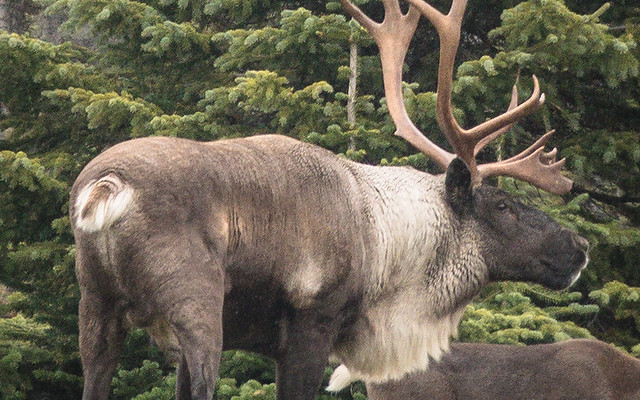The boreal woodland caribou[1] also known as woodland caribou, woodland caribou (boreal group), forest-dwelling caribou, Rangifer tarandus caribou.[Notes 1][2] Boreal woodland caribou are primarily, but not always, sedentary.[Notes 2][3][4][5][6] The woodland caribou is the largest of the caribousubspecies[7][8] and is darker[9] in colour than the barren-ground caribou.[10] Valerius Geist, specialist on large North American mammals, described the “true” woodland caribou as ”the uniformly dark, small-manned type with the frontally emphasized, flat-beamed antlers” which is “scattered thinly along the southern rim of North American caribou distribution.” Geist asserts that ”the true woodland caribou is very rare, in very great difficulties and requires the most urgent of attention”, but suggests that this urgency is compromised by the inclusion of the Newfoundland caribou, the Labrador caribou, and the western Osborn’s caribou in the Rangifer tarandus caribou subspecies. In Geist’s opinion, the inclusion of these additional populations obscures the precarious position of the “true” woodland caribou.[9]
The national meta-population of this sedentary boreal ecotype spans the boreal forest from the Northwest Territories to Labrador. They prefer lichen-rich mature forests[11] and mainly live in marshes, bogs, lakes, and river regions.[12] [13] The historic range of the boreal woodland caribou covered over half of present-day Canada,[5] stretching from Alaska to Newfoundland and Labrador and as far south as New England, Minnesota, Wisconsin, Michigan, Idaho, and Washington. Woodland caribou have disappeared from most of their original southern range. The boreal woodland was designated as threatened in 2002 by the Committee on the Status of Endangered Wildlife in Canada (COSEWIC).[14] Environment Canada reported in 2011 that there were approximately 34,000 boreal caribou in 51 ranges remaining in Canada.(Environment Canada, 2011b).[15] In a joint report by Canadian Parks and Wilderness Society (CPAWS) and the David Suzuki Foundation, on the status of woodland caribou, claim that “the biggest risk to caribou is industrial development, which fragments their habitat and exposes them to greater predation. Scientists consider only 30% (17 of 57) of Canada’s boreal woodland caribou populations to be self-sustaining.”[4][5] “They are extremely sensitive to both natural (such as forest fires) and human disturbance, and to habitat damage and fragmentation brought about by resource exploration, road building, and other human activity. New forest growth following destruction of vegetation provides habitat and food for other ungulates, which in turn attracts more predators, putting pressure on woodland caribou.”[11]
(From: Wikipedia, April 2017)




